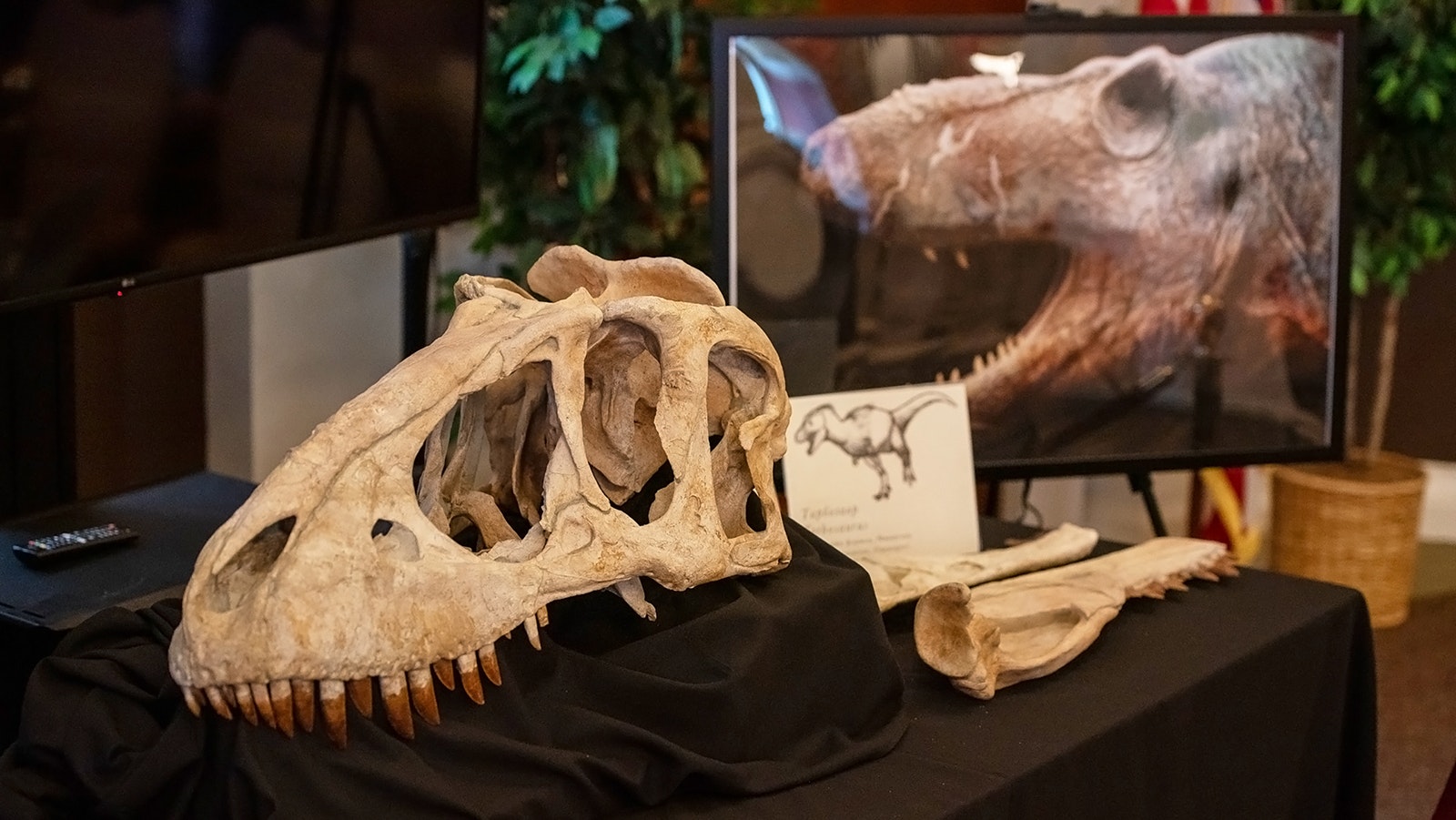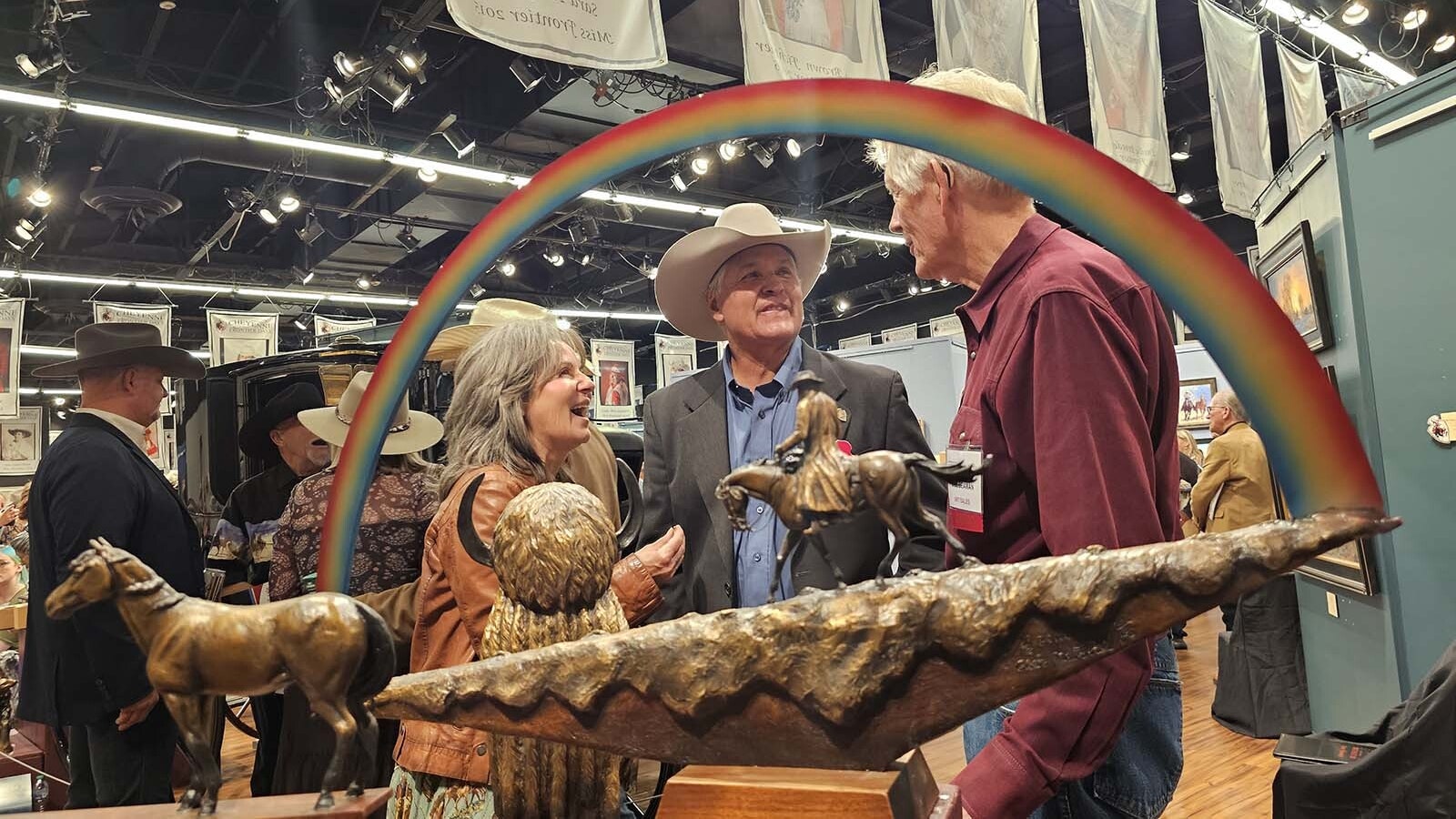Fossils are found everywhere around Wyoming, but finding a Mongolian dinosaur in a Cowboy State rock shop is unique.
And illegal.
The U.S. Department of Homeland Security held a repatriation ceremony at the Library of Congress in Washington, D.C., this week to return a collection of Mongolian fossils to that country. One of those fossils was the rare skull of a Tarbosaurus bataar, a Tyrannosaurus relative found in a Wyoming rock shop.
Thomas Holtz, Ph.D., is the principal lecturer on vertebrate paleontology at the University of Maryland and one of the world's foremost experts on Tyrannosaurus and its relatives. While thousands of miles part, Mongolia and Wyoming are both sparsely populated and rich in dinosaur fossils, he said.
"Mongolia regards fossils as part of their national heritage and not as minerals or trophies to be extracted and sold,” he told Cowboy State Daily. "Its huge size and low population make their territories hard to patrol. So, they still suffer from poaching of their natural resources.
"Thankfully, the last decade has seen a pattern where law enforcement, customs officials, and scientists around the world are more diligent so that stolen fossils might be returned to Mongolia.”
So how did a smuggled Mongolian fossil end up with a price tag in Wyoming?

A Mongolian Dinosaur In Wyoming
Homeland Security Investigations hasn't shared much information on any of the fossils. But when the agency got word that a Tarbosaurus skull was on display in a Wyoming retail shop, it launched an investigation.
Tarbosaurus is a meat-eating dinosaur so similar to Tyrannosaurus rex, it was once thought to be a different species of the same animal. Both lived during the Late Cretaceous Period in Asia and North America, respectively.
Several Tarbosaurus fossils have turned up in the United States, but all have been returned to the people of Mongolia, usually accompanied by criminal charges for those responsible for smuggling or selling the fossils.
The provenance of this Tarbosaurus skull hasn't been disclosed, but it definitely didn't belong in a Wyoming shop. The only explanation officials have given is that the fossil had been illegally smuggled out of Mongolia.
In 2012, investigators began a cultural property investigation to look into the Wyoming skull. Earlier that year, Homeland Security in New York initiated its own investigation after learning a U.S. auction house was planning a sale of Mongolian fossils.
Investigators in New York, Wyoming, and Arizona collaborated on 12 investigations to seize several Mongolian fossils and prosecute those responsible. The Tarbosaurus skull in Wyoming was included in the seizure.
Other fossils seized through the investigations include complete skeletons of Tarbosaurus and Gallimimus (the ostrich-like dinosaur that appears in “Jurassic Park”), a skull from the duck-billed hadrosaur Saurolophus, and several dinosaur nests and eggs.
At least one person pleaded guilty to criminal counts of illegal importation of dinosaur fossils.
An Important Fossil
The repatriation ceremony included the first public display of the incredible specimens, including the Tarbosaurus skull. But one of the more significant specimens on display was the skull of Alioramus, another Mongolian relative of Tyrannosaurus.
Homeland Security calls the skull "one of the best-preserved fossils ever found" of the 70 million-year-old dinosaur.
Holtz is happy this rare specimen will be returned to Mongolia, where it will be available for scientific research. Tarbosaurus fossils are more common, but even common fossils have enormous scientific potential.
"Alioramus is still only poorly understood," Holtz said. “So new fossils will help us to better understand the anatomy, ecology, and evolutionary relationships of this distinctive dinosaur. And while Tarbosaurus fossils are more common, their abundance means we can study this dinosaur in more detail to understand its biology."

Ill-Gotten Gains Of The Gobi
Fossils from Mongolia's Gobi Desert are legendary for their exquisite preservation.
Dinosaurs were frequently unexpectedly buried in sandstorms or under collapsing dunes. The sudden death and immediate burial led to phenomenal preservation.
The beauty of Mongolian fossils also makes them desired by international collectors. Despite international law, specimens have been illegally excavated, smuggled out of Mongolia, and sold on the black market or through private vendors.
Dinosaur eggs are among the most common Mongolian dinosaur fossils that show up for sale. The first dinosaur eggs ever found were discovered during a 1925 expedition to the Gobi Desert by the American Museum of Natural History in New York, New York.
Author Paige Williams published “The Dinosaur Artist: Obsession, Betrayal, and the Quest for Earth's Ultimate Trophy,” a book about a similar situation where a Tarbosaurus skeleton was auctioned off in the United States before being seized and returned to Mongolia.
While these dramatic cases of fossil seizure make great stories and headlines, Holtz says many people are being proactive by willingly returning fossils to Mongolia.
"While this case required the intervention of law enforcement, there have been several cases of voluntary Mongolian fossil repatriation, where the buyer wasn't aware of the illegal status of their purchase and were convinced that the right thing to do was to return these specimens to the nation to which they belong," Holtz said.
In the US, Finders Keepers
In the United States, while there are strict laws regarding fossils found on public land, any fossils found on private land are the property of landowners. They can choose to do anything they'd like with their property, which is why so many dinosaurs and other fossils found in Wyoming end up in museums and private collections in other states and nations.
Unlike the United States, Mongolia has patrimony laws that declare all fossils found in the nation rightfully belong to the people and government. Because of this, it is illegal for any fossils to be exported from the country without permission.
And all the fossils in the repatriated collection were illegally imported into the United States, and each was either part of a private collection, on the auction block, or waiting to be sold.
Several American T. rex fossils have taken up international residency, but Mongolian Tarbosaurus fossils belong in Mongolia. And the U.S. government says it will ensure all Mongolian dinosaurs find their way home, even if they end up in the wilderness of Wyoming.
Andrew Rossi can be reached at: Arossi@CowboyStateDaily.com
Andrew Rossi can be reached at arossi@cowboystatedaily.com.





